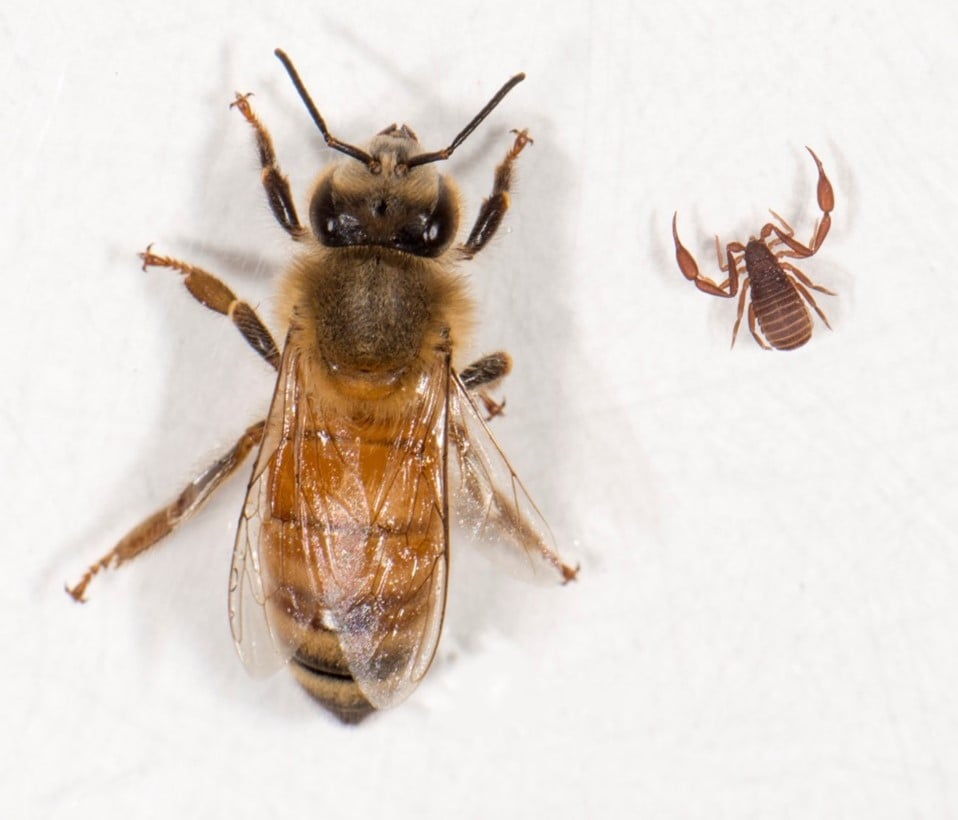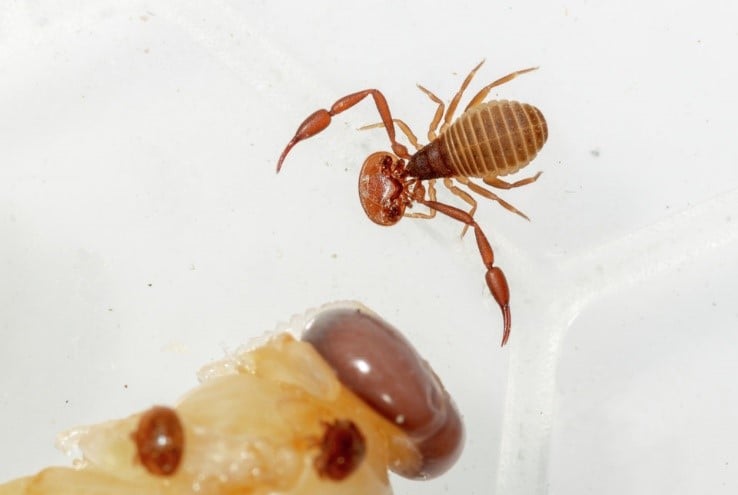Do our bees have useful associates that attack Varroa mites? – you can help.

Above: A honey bee next to an adult Chelifer cancroides (pseudoscorpion). Image courtesy Robert Lamberts, PFR
With the threat of Varroa mite looming large, it might be helpful to see what defences our bees may have in or around their hives. Overseas where insecticide resistance in Varroa mite is a concern, researchers have been testing Varroa mite predators that are compatible with bees.
One candidate is the pseudoscorpion Chelifer cancroides. This critter has been studied by New Zealand bio-protection researcher with beekeeping experience, Ron van Toor (Plant & Food Research, NZ (PFR)). The pseudoscorpion isn’t an actual scorpion (it has no sting) but it is a distant relative, and readily attacks Varroa mites – even when it is a small juvenile.
Ron’s work has shown that pseudoscorpions have no interest in bees or their young, and live comfortably in modified hive bottom boards from where they enter the hive to search for mites. The bees tolerate their presence. The questions are, could they be a tool to counter Varroa mites and where are they in Australia?


Above left: A very young pseudoscorpion eating a varroa mite. Image courtesy of Sam Read, PFR
Above right: An adult pseudoscorpion eating a varroa mite next to a parasitised honey bee drone pupae. Image courtesy of Robert Lamberts, PFR
Ron is linked to an international group led by Mary Whitehouse (NSW Department of Primary Industries /Macquarie University) interested in identifying tools that could be used against Varroa mite in Australia should the unthinkable happen. This team includes Elizabeth Frost (NSW DPI), Juliana Rangel (Texas A&M), and Mark Harvey (Western Australian Museum). Mark, who is a world expert on pseudoscorpions, said that Chelifer cancroides are in Tasmania, but haven’t yet been reported from the Australian mainland. Our next step is to see if these critters are on the Australian mainland, or if other Australian pseudoscorpions could be effective against Varroa mites.
This is where you could help.
If you find a pseudoscorpion near your hive (or your house or chicken pen as they hang out there too) please photograph it with your phone, and send the picture to Mark Harvey (E: [email protected]; or 0407 553 567). If possible, capture the critter (it won’t bite or pinch), put it in a zip-lock plastic bag or small jar, and pop it in the freezer (with the date and location where you caught it). Freezing it means that later, if it is a relevant species of pseudoscorpion, it can be formally identified and have its DNA assessed. The photographs will help us find out if these critters are on the mainland, or if there are other useful pseudoscorpions out there that could be called into service if necessary.
Managing Varroa mite, should it evade eradication in Australia, will require a range of tools. Predators that take out Varroa mites could be part of the pest management toolbox. This survey is an initial step to increase our preparedness.
More information
Acknowledgements:
This article was peer-reviewed by Elizabeth Frost and Nadine Chapman.


One comment, add yours.
Wayne Osland
Work needs to be done on weather the cockroaches we have in Au ,to find out if they predate the mite .I often see whole family’s inside some hives happily living off the detritus of the hive